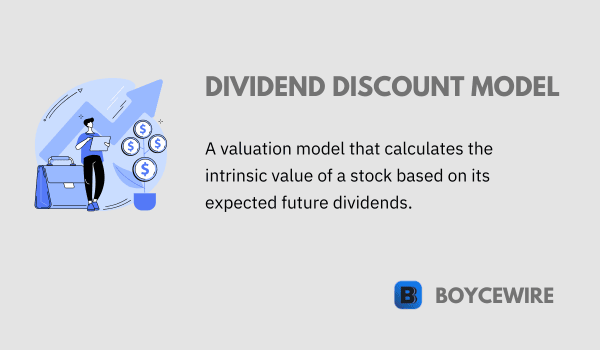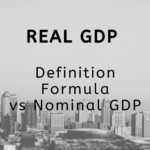Table of Contents ![]()
- What is the Dividend Discount Model?
- Understanding the Dividend Discount Model?
- Types of Dividend Discount Model
- Calculating using the Dividend Discount Model
- Applications of the Dividend Discount Model
- Advantages of the Dividend Discount Model
- Disadvantages the Dividend Discount Model
- Examples of the Dividend Discount Model
- FAQs
Dividend Discount Model: Types, How to Calculate & Examples

What is the Dividend Discount Model?
The Dividend Discount Model (DDM) is an essential financial valuation method that investors use to estimate the intrinsic value of a company’s stock. Based on the premise that a stock’s worth is equivalent to the present value of all its future dividend payments, the DDM is a cornerstone principle in the field of finance.
As its name suggests, the model discounts future dividends back to the present day, providing a dollar value that represents the fair value of the stock. If the fair value is higher than the current market price, the stock could be undervalued, suggesting an investment opportunity. Conversely, if the fair value is lower than the market price, the stock might be overvalued.
Key Points
- The Dividend Discount Model (DDM) is a valuation technique employed to ascertain the inherent worth of a stock by considering its projected dividends in the future.
- It assumes that the value of a stock is the present value of its future dividends, discounted at an appropriate discount rate.
- The DDM can be used to estimate the fair value of a stock and help investors make informed decisions about buying or selling.
Understanding the Dividend Discount Model (DDM)
The Dividend Discount Model (DDM) is grounded in the theory of the time value of money, which posits that a dollar today is worth more than a dollar in the future, primarily because the money can be invested to earn interest or dividends. In essence, the DDM attempts to calculate the present value of a company’s future dividends and subsequently equate this amount to the stock’s fair value.
There are two main assumptions in the DDM:
- Dividends are the only cash flows that shareholders receive: It is assumed that dividends are the only benefits that investors get, and hence they form the basis of the company’s value.
- Dividends are predictable and grow at a constant rate: The DDM assumes that dividends will grow at a steady rate indefinitely into the future.
In practical terms, the DDM can be a valuable tool in investment decision making. If the DDM calculation suggests that a stock is undervalued compared to its current market price, it may represent a potential investment opportunity. On the contrary, if the DDM calculation yields a fair value that is less than the stock’s current market price, it could imply that the stock is overvalued.
However, it’s worth noting that while the DDM can provide a good starting point, it shouldn’t be the only tool used for investment decisions. Other factors like the company’s financial health, the industry’s outlook, and the market’s overall condition should also be considered.
Types of Dividend Discount Model (DDM)
The Dividend Discount Model (DDM) can be broken down into three primary types, which vary in terms of the assumptions made about the dividend’s growth rate.
- Zero Growth Model This model, also known as the Gordon Growth Model, assumes that dividends will stay the same indefinitely – they neither increase nor decrease. This type of DDM is typically used for companies in stable industries where substantial growth or contraction is unlikely.
- Constant Growth Model Also known as the Gordon Growth Model, this model assumes that dividends will grow at a constant rate indefinitely. The constant growth model is used for companies that are expected to experience steady and predictable growth. This is the most commonly used form of the DDM.
- Variable Growth Model This model, also known as the Multi-Stage Dividend Discount Model, allows for the dividend growth rate to change over time. This type of DDM is used when a company is expected to experience different growth phases. For example, a company might have high growth for a few years followed by a steady, constant growth rate.
Each model type is suited for different situations and companies, so it’s essential to select the appropriate model based on the characteristics of the company being evaluated and its expected future growth. It is also crucial to remember that these models, like all financial models, are dependent on the quality and accuracy of the assumptions and input data. Consequently, the resulting valuations should be considered as estimates that need to be complemented with other valuation techniques and due diligence.
Calculating Using the Dividend Discount Model (DDM)
The process of calculating the intrinsic value of a stock using the DDM will vary slightly depending on which type of model you’re using (zero growth, constant growth, or variable growth). Here, we will focus on the most commonly used version, the constant growth model.
The formula for the Constant Growth DDM is:
P = D1 / (k – g)
where:
- P is the price of the stock.
- D1 is the expected dividend in the next period.
- k is the discount rate or required rate of return.
- g is the constant growth rate of dividends.
Let’s break down the steps involved in the calculation:
- Estimate the Next Period Dividend (D1): You need to forecast the expected dividend in the next year. You can use historical dividend data and growth rates to make this estimate.
- Determine the Discount Rate (k): The discount rate is the required rate of return for the investment. It is typically the investor’s opportunity cost, i.e., the return they could have earned from an alternative investment of equivalent risk. This might be the return on a market index or the average return on a similar stock.
- Estimate the Dividend Growth Rate (g): The growth rate should be the expected constant annual growth rate for dividends. It can be estimated using the company’s historical dividend growth rate or analysts’ forecasts.
- Substitute the Values into the Formula: Once you have estimates for D1, k, and g, you can substitute them into the DDM formula to calculate the intrinsic value of the stock.
It’s essential to remember that the calculated stock price is an estimate. The DDM is based on several assumptions, such as a constant dividend growth rate, which might not hold true in the real world. Therefore, investors should use this model as one tool among many in their decision-making process.
Applications of the Dividend Discount Model (DDM)
The Dividend Discount Model finds significant use in the finance industry, and it is particularly relevant for those engaged in investing, financial analysis, and portfolio management. Here’s how:
- Valuation of Stocks The primary application of DDM is in estimating the intrinsic value of a company’s stock. By comparing the intrinsic value with the current market price, investors can make informed decisions about whether a stock is overvalued or undervalued.
- Investment Strategy DDM can form a crucial part of an investor’s strategy, especially for those investing in dividend-paying companies. Using the DDM, an investor can estimate the present value of future dividends, which can serve as a good indicator of a company’s worth.
- Fundamental Analysis In fundamental analysis, DDM is a useful tool for assessing the attractiveness of a company as an investment. Fundamental analysts consider a company’s dividends as a tangible return on investment, thus a reliable indicator of a company’s profitability and financial health.
- Portfolio Management For portfolio managers, DDM can be used to assess the value of different stocks in a portfolio, aiding in the selection, balancing, and diversification process.
- Corporate Finance On the corporate side, DDM can help managers understand how their dividend policies affect the company’s perceived value. This understanding can inform decisions related to dividend payouts, capital structure, and other strategic considerations.
While DDM has several valuable applications, it is crucial to remember that it is not suitable for all companies or situations. For instance, it is less applicable to companies that do not pay dividends or have an unstable dividend payout history. As such, it should be used in conjunction with other valuation methods for a more comprehensive analysis.
Advantages of the Dividend Discount Model (DDM)
- Simplicity The DDM is straightforward in its concept and computation, which makes it accessible for both financial professionals and individual investors.
- Focus on Dividends As dividends are a tangible return to the shareholders, the DDM’s focus on dividends gives a clear picture of how much return an investor can expect to receive in the future.
- Intrinsic Value The DDM helps estimate the intrinsic value of a stock based on the present value of future dividends, rather than relying solely on market price. This can help in identifying potential over or undervalued stocks.
- Long-term Perspective The model encourages a long-term view of investing, which can be beneficial in an environment where short-term trading and speculation are prevalent. This long-term perspective aligns with the strategies of many value investors.
- Useful for Stable Dividend Payers The DDM works best for companies with stable and predictable dividends, which often includes well-established companies in mature industries. For such companies, the DDM can provide a reliable valuation.
- Focus on Cash Flows DDM emphasizes the cash flows that the company is returning to its shareholders, which can be a more reliable indicator of the company’s financial health than metrics that are easily manipulated by accounting practices.
While these are notable advantages, the model also has its limitations. Not all companies pay dividends, and among those that do, the dividend payout can be irregular. The model also assumes that dividends will grow at a constant rate indefinitely, which may not always be a realistic assumption. Hence, it’s essential to use the DDM alongside other valuation tools to gain a more comprehensive perspective.
Disadvantages of the Dividend Discount Model (DDM)
- Limited Applicability DDM is only applicable to companies that pay dividends. Many companies, especially in the tech sector or other growth industries, prefer to reinvest their earnings into the business rather than distribute them as dividends. For such companies, DDM cannot provide a valid estimate of value.
- Assumption of Constant Growth DDM assumes that dividends will continue to grow at a constant rate indefinitely. This is an oversimplified assumption, as few businesses can sustain a constant growth rate over the long term. Changes in the market, competition, and company strategy can significantly affect the growth rate of dividends.
- Sensitivity to Inputs The calculated value is very sensitive to the inputs of growth rate and discount rate. A small change in either of these can have a significant impact on the estimated value of the stock.
- Overvaluation The model tends to overvalue stocks if the estimated growth rate is higher than the actual rate. This could lead investors to pay more for a stock than its actual worth.
- Neglect of Company Fundamentals DDM mainly considers the company’s dividends and disregards other fundamentals like the company’s earnings, cash flow, book value, or macroeconomic factors affecting the business.
- Doesn’t Account for Share Repurchases Many companies return value to shareholders through share repurchases in addition to, or instead of, dividends. DDM doesn’t take into account share buybacks in its valuation.
While the DDM can provide useful insights, these disadvantages mean it should be used with caution and supplemented with other valuation methods to get a more comprehensive understanding of a company’s value.
Examples of Dividend Discount Model (DDM)
Let’s consider a practical example of how the Dividend Discount Model can be used to estimate the value of a stock.
Example 1
Company A has just paid a dividend of $1.50 per share. Its dividends are expected to grow at a steady rate of 5% per year, indefinitely. The required rate of return for equity investors in Company A is 10%.
Using the Gordon Growth Model, a form of DDM, the intrinsic value of the stock can be calculated as follows:
Value = D0 * (1+g) / (r-g)
Where:
D0 = the dividends just paid = $1.50
g = the growth rate of dividends = 5% or 0.05
r = the required rate of return = 10% or 0.10
Plugging the numbers into the formula, we get:
Value = $1.50 * (1 + 0.05) / (0.10 – 0.05) = $1.575 / 0.05 = $31.5
So, according to the Dividend Discount Model, the intrinsic value of a share in Company A is $31.5.
Example 2
Consider another scenario, where the company is not expected to grow at all, i.e., the growth rate is 0%. This is known as a zero-growth model, a special case of the Dividend Discount Model.
Company B has just paid a dividend of $2 per share, and the required rate of return for equity investors is 8%.
In this case, the value of the stock can be calculated simply by dividing the dividend by the required rate of return:
Value = D0 / r = $2 / 0.08 = $25
So, according to the Dividend Discount Model, the intrinsic value of a share in Company B is $25.
These examples demonstrate how the Dividend Discount Model can be used to estimate the value of a stock, given assumptions about dividends, their growth rate, and the required rate of return. However, remember that these are overly simplified examples, and actual calculations would need to consider other factors and use more complex models.
FAQs
The Dividend Discount Model (DDM) is a financial tool used to evaluate the value of a stock by estimating its future dividends and discounting them to their present value.
The DDM calculates the present value of expected future dividends, taking into account factors such as dividend growth rate and required rate of return.
The DDM helps investors assess whether a stock is overvalued or undervalued by comparing its calculated intrinsic value with the market price.
The key inputs for the DDM include the expected dividend per share, the dividend growth rate, and the required rate of return.
About Paul
Paul Boyce is an economics editor with over 10 years experience in the industry. Currently working as a consultant within the financial services sector, Paul is the CEO and chief editor of BoyceWire. He has written publications for FEE, the Mises Institute, and many others.

Further Reading
 Dynamic Pricing: Definition, Pros, Cons & Examples - Where prices actively fluctuate based on current demand.
Dynamic Pricing: Definition, Pros, Cons & Examples - Where prices actively fluctuate based on current demand.  How is Inflation Measured - So now we have looked at what money essentially represents, let us look at how inflation is measured. Inflation is…
How is Inflation Measured - So now we have looked at what money essentially represents, let us look at how inflation is measured. Inflation is…  Real GDP: Definition & How to Calculate - Real GDP is Gross Domestic Product (GDP) that accounts for inflation or deflation.
Real GDP: Definition & How to Calculate - Real GDP is Gross Domestic Product (GDP) that accounts for inflation or deflation. 
